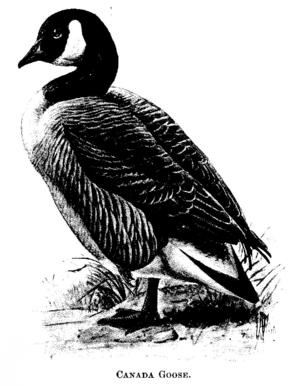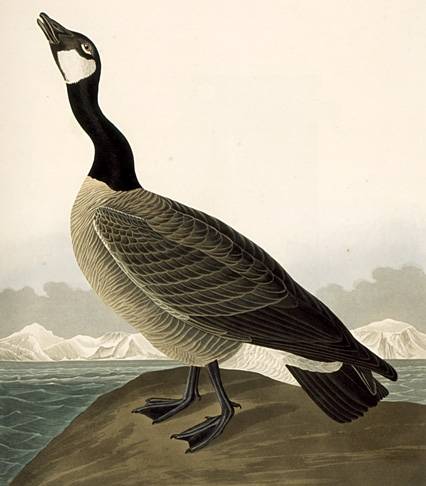Flight 1549 Bird Followup
Posted by: Loren Coleman on June 13th, 2009

It was the “feel good” story at the start of the year. A flock of Canada geese (Branta canadensis) apparently hit or were hit by an Airways jet, an Airbus A320. The plane then had to be ditched in the Hudson River, New York City, and sunk below the waterline.
The flight was US Airways Flight 1549, which took off at 3:26 p.m. on January 15, 2009, from LaGuardia, headed for Charlotte, North Carolina. All abroad were saved by the heroic actions of a fast-thinking, experienced flight crew. The world’s media were transfixed by the story.
For some of us, of course, the riddle of the birds remained.
One of the questions to be pursued was, “What birds were involved in the crash?”
Now comes a strange twist within the answer.
It was clear soon to most investigators that the birds were not anything more unusual than Canada geese (even though, of course, I used it to talk about the historical issue of Thunderbirds and plane hits). Most pointed to New York City’s permanent geese living in nearby wetlands year round, as the avian culprits in the mystery. Knowing for certain the type of geese was deemed critical as airports wished to devise strategies to scare away flocks out of future aircraft flight paths.
But a surprise awaited the forensic researchers, according to news released today.
The Feather Identification Lab at the Smithsonian National Museum of Natural History in Washington served as lead detective, with assistance from Chicago’s Field Museum.
“We try to tell people we’re here for a reason — and this case helps demonstrate that,” said ornithologist John Bates, who works with the Field Museum’s 480,000-bird collection. It includes inch-long hummingbirds, 5-foot ostriches and everything in between.
Rows of cabinets on the 116-year-old museum’s sprawling second floor hold specimens of 90 percent of the world’s 10,000 known bird species. But it was the Field’s collection of 2,700 samples of Canada geese — including some that migrated from the eastern Canada region of Labrador — that was the key to cracking the case.
Field ornithologists sent Labrador goose feathers and tissue to the Smithsonian, where tests showed the birds to blame for the US Airways accident were the Labrador type — not New York varieties that largely stay put year-round on the city’s waterways.
The clincher was a test in which Smithsonian scientists tested stable hydrogen isotope values in feathers — telltale markers that indicate where vegetation eaten by the birds grew. Migrating Labrador geese have eaten grass from different areas than the stay-at-home New Yorkers, and that showed up in the tests.
The findings, published in the June 8 editions of the journal “Frontiers in Ecology and the Environment,” mean New York airports may have to develop one method to keep migratory geese away from planes and another for the birds that nest in the city.
“A lot of people say ‘who cares about knowing the bird type,'” said Carla Dove, the aptly named program director at the Feather Identification Laboratory. “But that’s critical. The strategies differ according to species. If you have starlings or turkey vultures, you deal with it differently.”
Authorities may manage resident birds by harassing and culling them or modifying their habitat. Dealing with transient birds may require more elaborate methods, including recording their flight patterns or employing sensitive radar that detects their movement over runways.
New York City officials said this past week the city will trap and gas as many as 2,000 Canada geese over the next few weeks.

About Loren Coleman
Loren Coleman is one of the world’s leading cryptozoologists, some say “the” leading living cryptozoologist. Certainly, he is acknowledged as the current living American researcher and writer who has most popularized cryptozoology in the late 20th and early 21st centuries.
Starting his fieldwork and investigations in 1960, after traveling and trekking extensively in pursuit of cryptozoological mysteries, Coleman began writing to share his experiences in 1969. An honorary member of Ivan T. Sanderson’s Society for the Investigation of the Unexplained in the 1970s, Coleman has been bestowed with similar honorary memberships of the North Idaho College Cryptozoology Club in 1983, and in subsequent years, that of the British Columbia Scientific Cryptozoology Club, CryptoSafari International, and other international organizations. He was also a Life Member and Benefactor of the International Society of Cryptozoology (now-defunct).
Loren Coleman’s daily blog, as a member of the Cryptomundo Team, served as an ongoing avenue of communication for the ever-growing body of cryptozoo news from 2005 through 2013. He returned as an infrequent contributor beginning Halloween week of 2015.
Coleman is the founder in 2003, and current director of the International Cryptozoology Museum in Portland, Maine.










At least the methods stated in the article are more realistic than what some Animal Rights group are suggesting, that the airports be shut down.
Sorry, Charlie, that ain’t gonna happen. Nor it should.
True, shutting down the airports is a bit more than extreme, as a solution to this problem. At the same time, considering that a migrant population was responsible for the trouble in this case, rounding up 2000 resident geese and gassing them doesn’t seem all that helpful either, and it sounds like an awful lot of work for no really good reason, besides.
I think it’s kind of funny that we make such a habit of killing off members of other species for our own convenience. Shouldn’t we, instead, design something that keeps the bird-bits from getting into the plane engines and causing serious problems? Or is that just too expensive to even consider?
Once again, it seems, monetary concerns prevail over ecological ones, and likewise with short-term solutions over long-term ones.